Battlefield is set in east UP; the three main competitors have chinks in the armour
Clearly, a highly competitive battle is in the offing between the incumbent BJP, the SP-BSP alliance and the Congress. Can Priyanka script a fresh, alternative vision moving beyond Ram Mandir and goshalas?

The entry of Priyanka Gandhi into the formal organisation of the Congress party as AICC General Secretary of UP East has introduced a new element into politics in this key state. The move, ahead of the 2019 national elections, has generated tremendous media interest with many observers arguing that it would hurt the BJP and the SP-BSP alliance, which till then was deemed as well-placed. Priyanka is immensely popular, with a charismatic personality, and has played an important role in the party’s backroom politics and her induction has enthused party workers in UP. But, much will depend in the now triangular fight, not only on the personality of political contenders, but also the strengths and weaknesses of the three competing parties and their campaign strategies on the ground.
While the Congress is perceived as a weak party, out of power since 1989, today it appears reinvigorated compared to 2014 or 2017. Its ability to limit the seats won by the BJP to 99 in the Gujarat 2017 assembly elections, form a coalition in Karnataka in 2018 despite the BJP emerging as the single largest party, and recent successes in MP, Rajasthan and Chhattisgarh, point to a new dynamism under the leadership of Rahul Gandhi. Based on this new-found confidence, following the formation of the SP-BSP alliance, the party has announced that it will contest all the seats in UP.
Undoubtedly, eastern UP faces tremendous challenges as the region has powerful leaders: Narendra Modi and Yogi Adityanath from the BJP, and the Akhilesh-MayawatiSP-BSP alliance. Modi’s carefully crafted image using social media, his forceful speeches, well-organised party support-structure and highly aggressive, often offensive campaigns, against the Opposition during past elections, have won him considerable support. Similarly, Yogi Adityanath since the late 1990s has built a strong organisation as the head of the Gorakhnath Math and the Hindu Yuva Vahini.
The SP-BSP leaders, fresh from their joint victory in Gorakhpur and Phulpur in eastern UP in the important constituencies of the chief minister and deputy chief minister, have decided on a 38:38 seat sharing, leaving just two — Amethi and Rae Bareilly — to the Congress. The alliance hopes to decimate the BJP and appeal to the large population of backwards and Dalits and Muslims in eastern UP. The Congress was initially seen as a possible partner in the alliance as it could bring down the BJP’s seat tally even further. But due to its weak presence in the state, the alliance partners were not willing to concede more seats. The resulting division of votes could help the BJP as it could divide both the lower caste and minority vote between the Congress and the alliance.
However, there are chinks in the armour today that Priyanka could skillfully exploit in both the BJP and the SP-BSP alliance. Modi remains a popular leader but there are unfulfilled poll promises for UP, such as introducing rapid development, resolving the farm crisis, improving health and education in the state. On the other hand, policies like demonetisation and a poorly implemented GST have caused misery to the poor and small businesses. There is rising anger among Dalits due to incidents of violence against them and attempts to dilute the SC/ST Act. Similarly, Yogi Adityanath’s tenure has been marked by failures: Decline in law and order, police encounters, lack of jobs, poor public health evident in the death of 40 children in a Gorakhpur hospital in 2017, unhappiness among farmers over the agrarian crisis, non-payment of arrears to sugarcane farmers etc. The BJP’s allies in eastern UP such as the Apna Dal and smaller parties are also unhappy at being ignored.
Nor is the base of the BSP and SP as strong today as it was in the 1990s/early 2000s. Dalits, fragmented between the BJP, BSP and smaller groups, are in search of a party that could help fulfill their economic aspirations. Similarly, efforts by the SP to homogenise the backwards have not succeeded, with the MBCs voting in eastern UP for the BJP or the Apna Dal; the SP and BSP seem over-confident of gaining the support of the Dalits, OBCs and Muslims. The Congress decision to fight on all 80 seats could also be a setback for the alliance as it has created fresh avenues for prospective candidates of these parties denied the opportunity to contest, as both will contest on just 38 seats each. Given the strong possibility of a division of votes, some observers point to the likelihood of an undisclosed tactical understanding between the Congress and the SP-BSP leaders, as the BJP is the common enemy.






































No hay comentarios:
Publicar un comentario